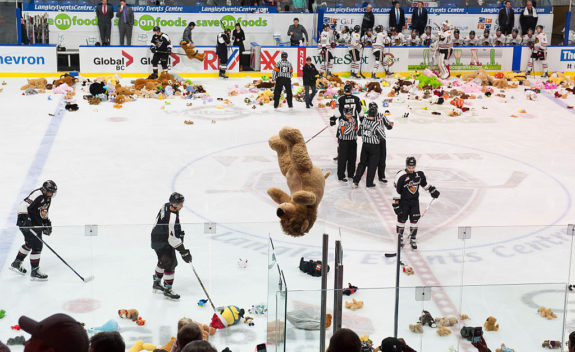There are many things that are absolutely synonymous with hockey: the sound of skates grinding across the ice. The ring of a puck careening off the crossbar. Slapshots. Black eyes. Missing teeth.
And, since 1993, one more thing has been increasingly associated with hockey, particularly around the holidays: the sight of thousands of stuffed animals flying from the stands down onto the ice.
We’re talking, of course, about the teddy bear toss, a tradition that has swept not only across Canada and the United States, but around the world, since its humble beginnings in a mountain town in British Columbia in 1993. It’s a tradition that allows hockey to give back, in the most delightful way possible.
Kamloops Origins
The Kamloops Blazers have given us a lot of great players (Jarome Iginla, Mark Recchi, and Scott Niedermeyer, just to name a few), but perhaps the team’s greatest gift to the hockey world was the tradition it is believed to have started 25 years ago this month: the teddy bear toss.

It was on Dec. 5, 1993, in a game between the Blazers and the Portland Winterhawks, that the first teddy bear toss happened. The brainchild of Kamloops’ marketing director Don Larson, the promotion was simple: during the game, fans would be encouraged to throw teddy bears and other stuffed animals on the ice, that would then be distributed to local children to spread warmth and cheer during the holidays. Larson had big dreams that a few hundred bears might be donated.
It wasn’t until the game’s first goal — scored by Brad Lukowich and assisted by Darcy Tucker and another Kamloops’ great, Shane Doan — that Larson would see not a few hundred but over 2,400 teddy bears and stuffed animals rain onto the ice. It was there that a phenomenon was born, one that would spread across leagues, countries, and continents.
From Kamloops to the World
There is some debate as to whether Kamloops was actually the first to start the tradition or not. In an article with ESPN, Bob Brown, former general manager of the Blazers, confessed that it wasn’t their idea originally.
“I think it was Regina,” Brown told ESPN. “It wasn’t us. I know that.”
But when ESPN asked Regina who started the tradition, they said, you guessed it, the Kamloops Blazers.
While we may never be certain where the very first toss happened, we know that it is synonymous with Kamloops. But it didn’t stay there. The teddy bear toss spread like wildfire from its humble beginnings, moving across the CHL and becoming a staple for teams like the Calgary Hitmen. It moved from Canada down into America, and even ventured further out into the world, being introduced in Australia in 2014, and in Sweden in 2017.
It’s also become a tradition for the Hershey Bears of the American Hockey League, a fitting team name for the event. They hold the toss annually, and recently shattered their own record for bears collected in the event, with fans throwing 45,650 stuffed animals onto the ice. That’s over four bears for every seat in the Giant Center, where the Bears play their home games.
The Bears were breaking their own record from 2018, which in turn broke a record previously set by the Hitmen in 2015, when almost 29,000 stuffed animals rained onto the ice in the Scotiabank Saddledome, the home rink of the Hitmen and the Calgary Flames. The records are a playful competition, but that’s all for the better, as it’s the community that reaps the benefit of these events.
Bears for a Cause
The entire point of the teddy bear toss since the very beginning, at least since the first event in Kamloops, was to collect bears for local children in need. The bears that are collected are brought to nearby children’s hospitals, schools, food banks, churches, and other charities, where they are distributed to those who need them. But it doesn’t stop there.
Thanks to partnerships with local businesses and philanthropists, the bears are just the beginning. For the 2018 record-setting toss in Hershey, a partner promised to donate 50 cents per bear, while a season ticket holder upped the ante to $1. That means upwards of $50,000 were donated on top of all the animals that were collected.
And it isn’t just the kids who gain from the promotion. Not only is it an unforgettable night for players on the ice, but they get to do some incredible things off the ice as well.
“We do a private visit to the hospital to see the kids and seniors. You’d be amazed what the experience is like for the young players, but also for the people,” Stu MacGregor, the vice president and general manager of the WHL’s Blazers, told ESPN. “I think it’s a good thing for our players because they see the difficulties that others are experiencing. The whole thing has developed into something special.”
The teddy bear toss has collected almost 350,000 bears in Calgary alone and has become a staple in markets across North America. But you won’t be seeing it in any NHL arenas anytime soon.
A Matter of Safety
Though it’s welcomed around Christmas time, fans throwing things on the ice is typically frowned upon, particularly in the NHL. They’ll never stop fans from tossing their caps on the ice when a home player scores a hat trick, but the NHL will not allow any teams to begin a teddy bear toss, for fear of the safety of their players and their fans.
“Player safety is an obvious reason, but so is fan safety,” an NHL spokesman told ESPN via email. “At NHL arenas, a high percentage of anything thrown from the stands would hit other fans.”
The spokesman makes a valuable point, that NHL arenas are generally larger than AHL and CHL arenas, and therefore it would be harder to get the bears onto the ice. But perhaps they forget that the Hitmen, who host one of the biggest annual tosses, play their home games in an NHL arena. The Saddledome is the seventh-largest venue in the NHL and holds over 19,000, yet the bears seem to find their way onto the ice just fine.

The NHL clearly must do everything it can to protect the health and safety of its players and its fans, but one wonders if the league’s head is in the right place on this issue. The number of projectile teddy bear fatalities is exceptionally low, and the potential good that the League could do by encouraging this tradition in their arenas seems to outweigh the danger.
By no means are we questioning the charitable good that the NHL does. Hockey Fights Cancer is an incredible charity and just one of the many ways the League gives back. But the teddy bear toss is an incredible tradition and might be a new way for the NHL to serve its communities, and to have a little fun in the process.
25 Years and Going Strong
With or without an NHL presence, the tradition of the teddy bear toss is still going strong, as Hershey, Calgary, and even the originator, Kamloops, continue to host annual events. Over the past quarter-century, more than a million bears have been collected and donated, and we can only hope that there are millions more in the future.
The tradition of the toss continues to grow. Some teams (like the Hitmen, pictured above in 2019), even design special sweaters for the occasion. The players enjoy the game, the community benefits, and everyone goes home a little happier during the holiday season. Long live the teddy bear toss.